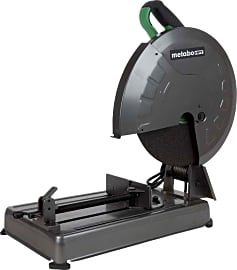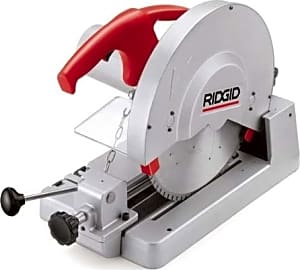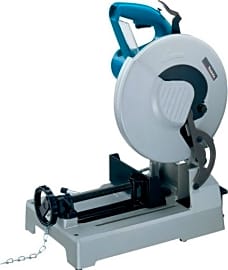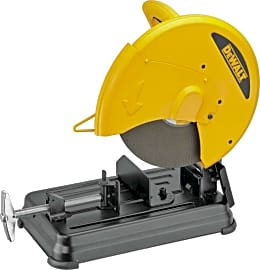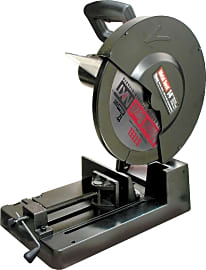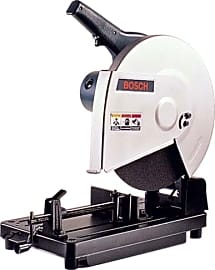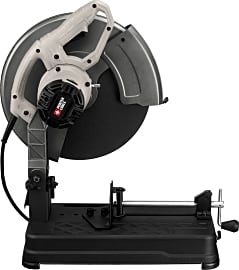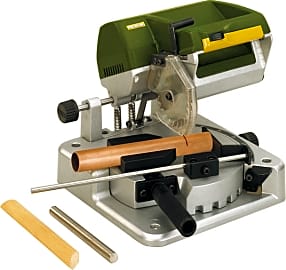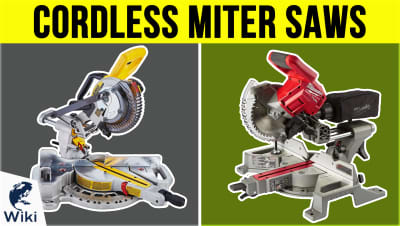The 10 Best Chop Saws

This wiki has been updated 39 times since it was first published in February of 2015. Frequently confused with miter saws and sometimes referred to as abrasive cutoff saws or cold circular saws, depending on the style you're dealing with, chop saws are the go-to tool for serious hobbyists and professional contractors looking to slice through ferrous and non-ferrous metals. Our selections for this category include a host of portable options available at a variety of price points. When users buy our independently chosen editorial selections, we may earn commissions to help fund the Wiki.
Editor's Notes
April 14, 2021:
All of our picks from last year still looked like great choices for this category. So, for the most part, all these saws made it off the chopping block and back onto our list, but we did wind up cutting the Makita 2414NB loose, recognizing that, as a discontinued tool, it’s only a matter of time until its availability expires.
Fortunately, we had no trouble sourcing an exciting new alternate listing from the same company: the 14-inch Makita XWL01PT is a cordless kit that combines the brand's XWL01Z saw with a pair of five-amp-hour batteries and a convenient dual-port charger. We gave this new addition a spot at the top of our list, because we love to see this level of cordless convenience offered by a power tool of this size, especially when its dressed up with all the standard features you look for in this category, like a brushless motor and electric brake.
It even has a handy indicator LED linked up with its overload protection (a seemingly simple extra that so many tools skip over), but I’ve got to say – because we are in the business of being critical, after all – that including two batteries in a kit is all fine and dandy if the tool only requires one, but since this saw requires two, you’re going to need to pick up an extra two (for a total of four) if you expect to keep this machine running all day on a job site.
As was explained thoroughly in the February 28, 2020 editor’s note for this page, this list is focused on simple saws that are primarily intended for metal fabrication. If you’re looking for one of those tools that tilts, leans, pivots, primarily cuts wood and often mistakenly gets called a chop saw on job sites, then you’ll probably want to leave this list behind and hop over to our rankings for miter saws. We even maintain a separate list for cordless miter saws.
February 28, 2020:
During this round of updates, we eliminated the DeWalt D28710 and Evolution Rage2 due to availability issues, and replaced the DeWalt D28715 and Hitachi CC14SFS with their newer versions: the DeWalt D28730 and Metabo HPT CC14SFS (note that all Hitachi power tools have now been rebranded as Metabo HPT). We also added the Ridgid 614 – a pricey dry-cut option that justifies its price with its performance, and the Bosch 3814 – an abrasive cut-off machine from the well-reputed company.
A note on semantics:
We restricted our rankings for this category to tools that fit the textbook definition of a chop saw: a circular saw mounted on a pivoting arm over a platform, designed to make 90-degree cuts through a variety of material and sometimes referred to as a cut-off saw (a redundant title, if I’ve ever seen one). However, when dealing with common construction-industry vernacular, it’s important to note that chop saw is very commonly used as a synonym for miter saw.
What’s the difference? Primarily that miter saws can be adjusted to make angled and beveled cuts, but practically speaking, another obvious differentiator is that miter saws are typically depended on to cut wood and other soft materials, while chop saws are normally the go-to for cutting harder materials like ferrous metals. There might be instances where, with the help of replacement blades, these tools can be used for the opposite purpose, but this can be extremely dangerous. Chop saws tend to turn at much faster speeds than miter saws, and at 4,000 RPM that blade can turn a nice piece of stock ugly in a hurry, if you aren’t careful. If you’re considering trying to outfit your chop saw for woodworking, do your due diligence and make sure that its manual confirms it’s a suitable use for the tool (also note that some cold-saw blades are suitable for cutting wood).
Some considerations to chop up while you research your purchase:
Abrasion vs. Cutting: Abrasive-chop-saw blades, which are often 14 inches in diameter, are essentially a giant version of an angle-grinder wheel, though they tend to be thinner. They’re relatively cheap to replace, but they can wear out fairly quickly. Abrasive machines can make cuts quickly and be quite affordable, but they’re loud, they create all kinds of sparks and they have a tendency to walk – which means you shouldn’t expect them to produce the cleanest or most-accurate cuts.
Cold-saw blades use teethed blades, not unlike what you’ve likely seen on other circular saws. They employ high-torque, low-speed motors to cut through tough materials, and while they take considerably longer than their abrasive counterparts, you can typically expect them to produce cuts cleanly and accurately. They’re called cold saws because their blades transfer heat to the debris they create while cutting, eliminating the hazardous heat and sparks associated with abrasive methods.
Cut Depth: A compact saw can be nice, if you’re looking to frequently lug it to job sites, but it won’t do you any good if it won’t cut through the material you’re working with. While saws with 14-inch wheels, like the DeWalt D28730 and Metabo HPT CC14SFS, often have a maximum cut-depth rating that's in the neighborhood of five inches, smaller models like the Evolution Rage4 are severely limited by their shallow, two-inch maximum cut depth.
Pivoting Functionality: As we’ve already discussed, chop saws by definition are incapable of any of the tilting, leaning and pivoting acrobatics of a miter saw. However, many models, like the Metabo HPT CC14SFS and the DeWalt D28730, feature pivoting fences that help facilitate angled cuts up to 45 degrees in either direction. The Porter-Cable PCE700 is half as good, with a fence that can swing 45 degrees left, and the Proxxon KGS 80 uses a bit of a different design, incorporating a rotating base with a 90-degree range of motion.
Special Honors
Baileigh Industrial Though certainly not the first place to look for affordable solutions, companies like Baileigh Industrial provide users with well-built machinery that's suitable for use in demanding settings like factories and fabrication shops. Their offerings include cabinet-style designs and models that run on three-phase power. baileigh.com
Everett Industries A good place to look for users with big budgets who are shopping for big saws, Everett Industries offers a diverse host of options, including models that accommodate 20-inch cutting wheels and machines outfitted with castors to improve their mobility. Just be prepared for price tags that frequently exceed $15,000. everettindustries.com
A Cut Above: Choosing A Fine Chop Saw
You can find affordable chop saw that are lightweight enough to be relatively portable, but potent enough to chop through hardwoods.
You will find a chop saw (or two or five) on almost every construction site around the world, whether the team is working on building or renovating a house, a department store, or a skyscraper. Chop saws are also ubiquitous in the garage or tool shed of any Do It Yourself enthusiast who takes pride and pleasure in his or her ability to handle many home repair and maintenance tasks without then need for a professional.
If you only need a saw for chopping lumber down to smaller sizes, such as might be merited by preparing sections of hardwood flooring or decking material, then a basic chop saw that only allows for straight, ninety degree cuts is a fine choice. You can find affordable chop saw that are lightweight enough to be relatively portable, but potent enough to chop through hardwoods.
On the other hand, top quality chop saws can cost considerably more. The massive price disparity is explained by myriad factors. The most obvious attribute you can expect from a more expensive chop saw are an adjustable blade angle. A compound chop saw is one that can have its blade turned to create cuts at various angles. These generally range from angles as acute as five degrees all the way to cuts at ninety degrees, aka a right angle. (By flipping the wood over, an acute angle can of course also be considered an obtuse cut.)
As you edge up the price scale, you'll find chop saws that not only create compound cuts, but that also tilt their blade on its axis to cut at an angle along the axis of a board, creating miter cuts with ease -- see below for more on this important technique.
Consider next the finesse afforded an operator by variable speed control. Lower priced saws tend to revolve at one fixed speed, reducing the opportunity for fine control. Some of the pricier varieties offer revolution per minute speed settings between 1,400 RPM and speeds as fast as 3,400 RPM.
While many people think power saws are only suitable for cutting through wood, in fact they can be used to cut through anything from metal pipes to PVC plastic tubing to brick, concrete, and more. However, before cutting through many such materials, you might need to switch out the standard blade of your chop saw with a cutting disc that was purpose built for a given material. For example, a grinding disc, often referred to as a cutoff wheel, can be installed in your chop saw and is used to cut its way through metals from copper to iron to steel. (Never try to cut metal using a blade intended for wood -- it will ruin the blade, cause dangerous sparks and debris, and will be woefully ineffective.)
Power Saw Safety Basics
Before you even plug in a chop saw, make sure you know exactly how to use the tool. Take the time to practice adjusting its varied knobs and locks that control the motion of the blade, the compound angle settings, and so forth. Ensure that the dust cover is in place and that the fence and gate area are clean of sawdust and debris.
Before you begin to operate your power saw, put on a pair of work gloves, protective eyewear, and consider a mask to cover your mouth and nose and ear muffs or ear plugs to protect your hearing. The more you will be using the saw, the greater the importance of these latter two items.
When using the saw, keep your eyes on the tool at all times and keep one hand firmly on the trigger and grip, the other holding the wood being cut firmly in place. Kickbacks are uncommon with these saws, so user carelessness is the greatest cause of accidental injury.
A Few Words On Cuts Of Wood
You don't have to be an expert carpenter to get good use out of a good chop saw. These tools are as suitable for shortening lengths of wood you want to burn in the fireplace or shaving a bit of height off of a mismatched table leg as they are for helping you make perfect miter cuts for joining those sections of quarter sawn oak.
Even if you have no aspirations of achieving a master's touch in carpentry, though, it can still be beneficial to learn a few of the proper terms most commonly used to discuss the cuts made with chop saws.
The most common example of a miter joint are the two 45 degree angle cuts that bring parts of a picture frame or door or window frame together.
But starting off with the saw itself, a chop saw is in fact properly called a miter saw and is designed primarily to cut across the grain of a piece of wood instead of cutting along its grain. (This is called a rip cut and is usually performed with a table saw -- think of the process of cutting a large piece of plywood into narrower boards for an example.) The word "miter" itself refers to the angular (also known as bevel) cut made primarily prior to the joining of two pieces of lumber. The most common example of a miter joint are the two 45 degree angle cuts that bring parts of a picture frame or door or window frame together.
The most common types of mill cuts you will find in wood intended for use in furniture, decorative shelving, or visible structure work are boards that have been plain sawn, quarter sawn, or rift sawn. The first cut refers to a section of lumber (a tree trunk, e.g.) that has been cut into as many boards as could be sourced from the wood in a series of parallel cuts all the way through the lumber.
Quarter sawn wood refers to a section of trunk first cut into four equal quarters which are then but into a a series of boards of varied size, each with plenty of the tree's rings exposed, creating a lovely surface to the wood. Finally the rift cut is the rarest and most expensive cut, as it wastes much of the wood. A rift cut piece of lumber is made by cuts that are all perpendicular to the trunk's core, with wedge shaped sections of wood between each mill cut discarded.


